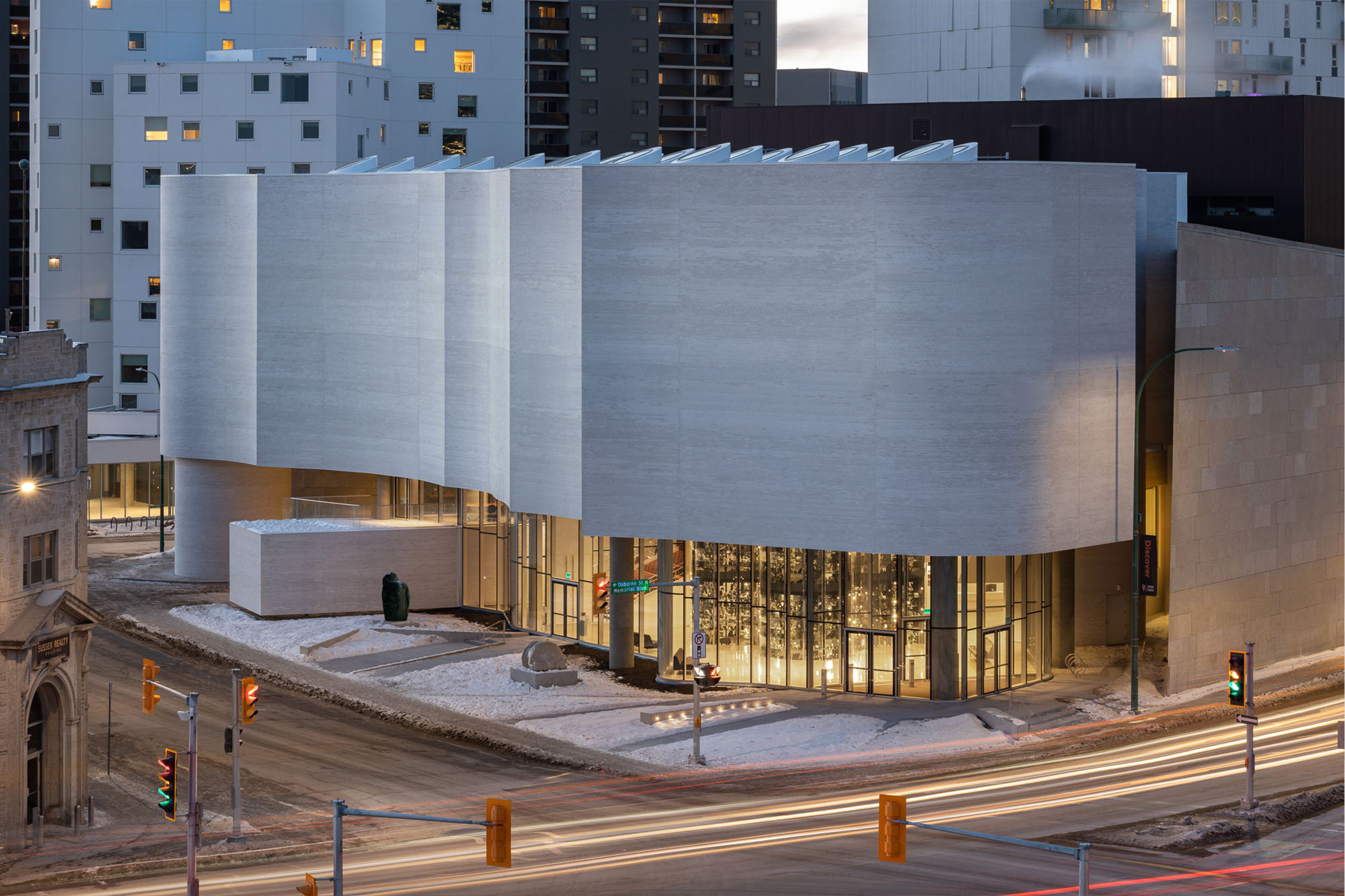Michael Maltzan’s design for Qaumajuq, the Inuit art center at the Winnipeg Art Gallery, was informed by a research trip to the far north.
By: Hadani Ditmars
For years, the world’s biggest public collection of contemporary Inuit art languished in the dark basement vault of the Winnipeg Art Gallery (WAG). Happily, the close to 14,000 pieces—many donated from the collection of local artist George Swinton, who helped popularize Inuit art in the midcentury—have now been liberated. They are on display in a new four-story, 40,000-square-foot facility adjacent to the museum named Qaumajuq, which in Inuktitut means “it is bright, it is lit.”
The new building is the fruit of years of consultation between the WAG and an Indigenous advisory circle, composed of Inuit as well as First Nations and Métis artists and educators. Qaumajuq’s form is also influenced by a 2013 trip that architect Michael Maltzan took to the Canadian north, visiting artists in the Nunavut communities of Pangnirtung, Kinngait (formerly Cape Dorset), and Iqaluit with Winnipeg-based architect George Cibinel—whose firm, Cibinel Architects Ltd., served as associate and technical architects on the project—WAG director and CEO Stephen Borys, curator of Inuit art Darlene Coward Wight, and photographer Iwan Baan.
Its curvilinear expression, says Maltzan, is a direct response to the advisory circle’s Douglas Cardinal–like request for “a space that was not prescribed by traditional orthogonal walls and room shapes.” Incorporating the feeling of vast northern landscapes as well as the looming presence of prairie in Winnipeg, the architect says he wanted to “explore the way space might communicate greater levels of continuity and endlessness.”
Located across the street from the former flagship department store of the Hudson’s Bay Company—the historic fur trading firm that displaced many Inuit communities and through which much of the WAG’s collection was acquired—and adjacent to the provincial parliament, Qaumajuq is both subject to and aiming to challenge existing colonial spatial context. As the new museum was conceived at the time of the Idle No More protest movement and born a few months before recent news of residential school horrors, it is clear that it should speak to issues of indigeneity in its design.
But formally, Maltzan refuses to be pinned down into literalism or essentialism. “I don’t think of it in that way,” he says, “in terms of indigenous or nonindigenous.” What the artists he visited wanted, he explains, “was a building that honored their work and their contribution artistically, just like any other artists would.”
To that end, Maltzan elevates and illuminates the work by making the entrance lobby a kind of urban vitrine, visible from street level, that displays 5,000 pieces on a series of stacked glass shelves topped by reflective chrome panels. Ascending three stories to the mezzanine, the stone-and-ivory carvings in what is called the “visible vault” appear to levitate, symbolically floating above the collection’s colonial roots. Here he also subverts the conventional anthropological way of displaying Inuit art, “pin-lit in a dark room,” contextualizing it instead within a global contemporary art world pantheon and granting it center stage.
The design simultaneously opens up the ground plane to pedestrians and passersby in the area, which is becoming a new city hub. This is something that the WAG’s existing gallery, an otherwise handsome 1971 Brutalist classic designed by Gustavo da Roza that the new building successfully embraces, failed to do. The Inuit Art Centre’s engagement with its surrounding environment recalls past projects by Maltzan like MoMA QNS and Inner-City Arts in Los Angeles, which are as much civic interventions as cultural spaces.
In shifting the scale from the ethnographic display style that often diminishes traditional carvings, Maltzan recalls his visit to the north where “an artist will be working on a sculpture that’s 12 centimeters long, in the midst of a vast landscape—but that piece has incredible power to hold attention.”
Similarly, in a subtle but powerful play of scale, the upstairs 8,000-square foot gallery called Qilak or “sky” in Inuktitut (currently showcasing the museum’s inaugural Inuit curated exhibition Inua, or “life force”) is defined by rectangular ceiling slits and deep, rounded skylights. These elements help summon a sense of endless Arctic landscape as well as the intimacy of the domestic sphere—de facto studio spaces for many Inuit artists—in what is the world’s largest gallery dedicated to their work.
In the choreography of the space, light dances organically from the luminescent exterior, which reads like an abstracted ice floe, through the lobby oculus and up the mezzanine’s curved stairwells leading to the gallery and fourth-floor studios. Here at Qaumajuq, whose architecture deftly supports the WAG’s mandate to engage with the community—including Winnipeg’s nearly 93,000 Indigenous citizens—the museum becomes a device for illumination, transparency, and connection.

